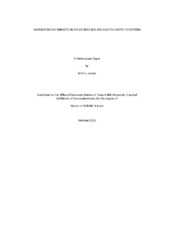| dc.description.abstract | Despite its relative distance from most populated regions of the world, the Arctic has been significantly impacted by anthropogenic contamination and climate change. The entire Arctic ecosystem has been affected, with upper trophic level predators such as polar bears (Ursus maritimus), ultimately experiencing the worst impacts. The vast group of contaminants classified as persistent organic pollutants (POPs) are the primary anthropogenic source of Arctic contamination. Temporal trends indicate some legacy contaminants such as DDT have been steadily decreasing. However, data reflect that perfluorinated carboxylic acid (PFCA), BFRs, and other substances are generally increasing in concentration among most polar bear populations. For most POPs, the highest concentrations are found among the East Greenland and Svalbard populations, with the lowest concentrations found in the Alaska population. Exposure to some POPs can reduce vitamin concentrations in tissue and blood, affect the endocrine system by altering thyroid, cortisol, and reproductive hormone synthesis and transport, alter the development and function of sexual organs, induce immunosuppression, damage internal organs, reduce bone mineral density, and alter behavior. Numerous new chemicals which have not been previously found in the Arctic and in polar bears are beginning to show up in tests of polar bear tissue samples. Concentrations of most metals are highest among western bear populations such as those in Alaska, with levels decreasing in an easterly direction. In polar bears, mercury is known to damage internal organs, the neurological system, and the endocrine system. Climate change is already impacting polar bears due to changes in sea ice and other factors and these effects are expected to worsen in the coming years. The current collection of data regarding the health effects of anthropogenic contamination and climate change on polar bears certainly indicate the situation merits continued and expanded research. | en |


